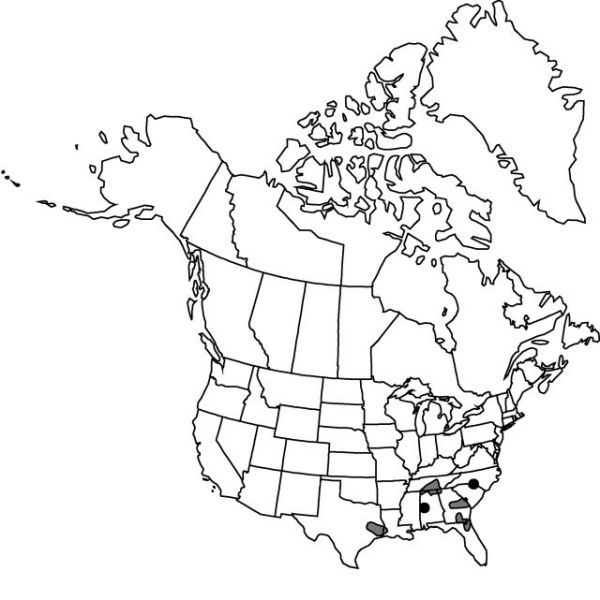Difference between revisions of "Schoenolirion croceum"
Amer. Bot. Fl., 344. 1870.
FNA>Volume Importer |
imported>Volume Importer |
||
| (6 intermediate revisions by 2 users not shown) | |||
| Line 8: | Line 8: | ||
}} | }} | ||
|common_names=Sunnybells;swamp candle | |common_names=Sunnybells;swamp candle | ||
| − | |basionyms={{Treatment/ID/ | + | |special_status={{Treatment/ID/Special_status |
| + | |code=F | ||
| + | |label=Illustrated | ||
| + | }}{{Treatment/ID/Special_status | ||
| + | |code=E | ||
| + | |label=Endemic | ||
| + | }} | ||
| + | |basionyms={{Treatment/ID/Basionym | ||
|name=Phalangium croceum | |name=Phalangium croceum | ||
|authority=Michaux | |authority=Michaux | ||
| + | |rank=species | ||
| + | |publication_title=Fl. Bor.-Amer. | ||
| + | |publication_place=1: 196. 1803 | ||
}} | }} | ||
|synonyms={{Treatment/ID/Synonym | |synonyms={{Treatment/ID/Synonym | ||
|name=Oxytria crocea | |name=Oxytria crocea | ||
|authority=(Michaux) Rafinesque | |authority=(Michaux) Rafinesque | ||
| + | |rank=species | ||
}} | }} | ||
|hierarchy=Liliaceae;Schoenolirion;Schoenolirion croceum | |hierarchy=Liliaceae;Schoenolirion;Schoenolirion croceum | ||
| Line 30: | Line 41: | ||
|elevation=0–400 m | |elevation=0–400 m | ||
|distribution=Ala.;Fla.;Ga.;La.;N.C.;S.C.;Tenn.;Tex. | |distribution=Ala.;Fla.;Ga.;La.;N.C.;S.C.;Tenn.;Tex. | ||
| − | |discussion=<p>Schoenolirion croceum is very localized on limestone outcrops in central Tennessee and northern Alabama, sandstone outcrops of the Alabama plateau region, granite outcrops of the Georgia and Carolina Piedmont, Selma chalk outcrops in western Alabama, and wet pinelands and boggy areas in more southern and western parts of its range. All of these habitats are very wet in spring and often very dry in summer.</p> | + | |discussion=<p><i>Schoenolirion croceum</i> is very localized on limestone outcrops in central Tennessee and northern Alabama, sandstone outcrops of the Alabama plateau region, granite outcrops of the Georgia and Carolina Piedmont, Selma chalk outcrops in western Alabama, and wet pinelands and boggy areas in more southern and western parts of its range. All of these habitats are very wet in spring and often very dry in summer.</p> |
|tables= | |tables= | ||
|references= | |references= | ||
| Line 39: | Line 50: | ||
-->{{#Taxon: | -->{{#Taxon: | ||
name=Schoenolirion croceum | name=Schoenolirion croceum | ||
| − | |||
|authority=(Michaux) Alph. Wood | |authority=(Michaux) Alph. Wood | ||
|rank=species | |rank=species | ||
| Line 53: | Line 63: | ||
|publication title=Amer. Bot. Fl., | |publication title=Amer. Bot. Fl., | ||
|publication year=1870 | |publication year=1870 | ||
| − | |special status= | + | |special status=Illustrated;Endemic |
| − | |source xml=https:// | + | |source xml=https://bitbucket.org/aafc-mbb/fna-data-curation/src/2e0870ddd59836b60bcf96646a41e87ea5a5943a/coarse_grained_fna_xml/V26/V26_623.xml |
|genus=Schoenolirion | |genus=Schoenolirion | ||
|species=Schoenolirion croceum | |species=Schoenolirion croceum | ||
Latest revision as of 21:16, 5 November 2020
Plants with prominent bulbs at tops of vertical rootstocks; bulbs ovoid to elongate, to 17 mm diam. Leaves 3–7, 20–32 cm × 5–8 mm, not withering to persistent fibers; blade flattened or somewhat keeled, usually equaling or exceeding inflorescence, base fleshy. Inflorescences seldom branched; bracts ovate-obtuse to lanceolate-acuminate. Flowers: tepals seldom strongly recurved, yellow, each with green or reddish abaxial stripe, 3–5-veined, ovate to ovate-oblong, 4.5–6 mm, apex obtuse; ovary green or greenish yellow. 2n = 24, 30, 32.
Phenology: Flowering mid Mar–mid Apr in south and west; Apr–mid May in north; dormant by late Jun.
Habitat: Rock outcrops, moist pinelands
Elevation: 0–400 m
Distribution

Ala., Fla., Ga., La., N.C., S.C., Tenn., Tex.
Discussion
Schoenolirion croceum is very localized on limestone outcrops in central Tennessee and northern Alabama, sandstone outcrops of the Alabama plateau region, granite outcrops of the Georgia and Carolina Piedmont, Selma chalk outcrops in western Alabama, and wet pinelands and boggy areas in more southern and western parts of its range. All of these habitats are very wet in spring and often very dry in summer.
Selected References
None.
